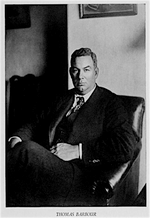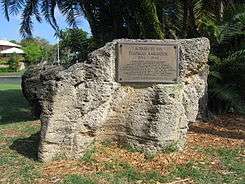Thomas Barbour
| Thomas Barbour, Ph.D. | |
|---|---|
 | |
| Born |
August 19, 1884 Martha’s Vineyard, Massachusetts |
| Died |
January 8, 1946 (aged 61) Boston, Massachusetts |
| Nationality | United States |
| Alma mater | Harvard University |
| Known for | Naturalist, author, professor, & director of the Museum of Comparative Zoology at Harvard University |
| Spouse(s) | Rosamond Pierce |
| Parent(s) | Colonel William Barbour & Julia Adelaide Sprague |
| Relatives | Senator William Warren Barbour (R NJ) (Brother) |

Thomas Barbour (August 19, 1884 – January 8, 1946) was an American herpetologist. From 1927 until 1946, he was director of the Museum of Comparative Zoology founded in 1859 by Louis Agassiz at Harvard University in Cambridge, Massachusetts.
Life and career
Barbour, the eldest of four brothers, was born in 1884 to Colonel William Barbour, and his wife, Julia Adelaide Sprague. Colonel Barbour was founder and president of The Linen Thread Company, Inc., a successful thread manufacturing enterprise having much business in the United States, Ireland, and Scotland. Although born on Martha's Vineyard, Massachusetts, where the family was spending the summer, Barbour grew up in Monmouth, New Jersey, where one of his younger brothers, William Warren Barbour, entered the political arena, eventually serving as U.S. Senator from New Jersey from 1931 to 1937 and again from 1938 to 1943.
At age fifteen, Thomas Barbour was taken to visit Harvard University, which, entranced by its Museum of Comparative Zoology, he later attended. At Harvard, he studied under Alexander Agassiz, son of Louis Agassiz. Having received his B.A., M.A., and Ph.D. from that university, Barbour joined the faculty in 1911 when his doctoral dissertation was published, and he took on the position of curator of reptiles and amphibians at the Museum of Comparative Zoology. Eventually he became the Alexander Agassiz Professor of Zoology and, in 1927, director of the museum. Although primarily interested in reptiles and amphibians, he also studied birds and insects, particularly butterflies. His biological interests, however, were remarkably diversified, and he is considered to be one of the last of a dying breed: a general naturalist.
His scientific travels took him through Africa, Asia, North America, South America, and Central America, among other regions. He particularly enjoyed Panama, Costa Rica, and Cuba, which he visited at length on at least thirty occasions beginning in 1908, generally staying in Soledad at the Harvard Botanical Gardens. Barbour served as custodian of these gardens from 1927 until his death in 1946.[1] In his book, Naturalist in Cuba, Barbour writes, "I suspect that I am the only living American naturalist who has visited all parts of the island again and again, for I am not only a Cuban by adoption, but a devoted friend of the land and its people." In addition to the expected scientific discussion of the island's flora and fauna, Barbour provides a description of Cuban society and culture.
He was elected a Fellow of the American Academy of Arts and Sciences in 1916.[2] In 1923 and 1924, he was one of the scientists and financial benefactors who founded the Barro Colorado Island Laboratory in Panama, location of the Smithsonian Tropical Research Institute. The island, originally a hilltop, sits in the middle of Gatun Lake, which was created when the Chagres River was dammed during the Panama Canal building project.
Along with better than 400 scholarly articles, Barbour wrote several books including the autobiographical Naturalist at Large (1943), Naturalist in Cuba (1945), A Naturalist's Scrapbook (1946), and That Vanishing Eden (1944), which explores the natural world of a remote, undeveloped Florida.
In 1906, Barbour married Rosamond Pierce of Brookline, Massachusetts. A two-year honeymoon took them through remote reaches of the Dutch East Indies, India, Burma, Java, China, and New Guinea with Barbour's wife helping him to photograph animals and collect specimens. Their union resulted in six children and eleven grandchildren. The family home was on Clarendon Street in Boston's Back Bay, with summers spent in Beverly Farms, Massachusetts.
During the last two years of his life he was in failing health, following a blood clot that had developed while he was in Miami. He was at the Museum of Comparative Zoology as usual on January 4, 1946, and in happy mood at home in Boston that evening. But he was stricken later in the night with cerebral hemorrhage, and died on January 8, without regaining consciousness.
Also, the street he grew up on was named after him, Thomas Barbour Drive, in Melbourne, FL; the street on which Ballard Park is located.
See also
References
- Notes
- ↑ Barbour 1946. Dustjacket back flap.
- ↑ "Book of Members, 1780-2010: Chapter B" (PDF). American Academy of Arts and Sciences. Retrieved May 17, 2011.
- Bibliography
- Barbour, Thomas. Naturalist at Large. Little, Brown and Company; Boston, MA, 1943.
- Barbour, Thomas. That Vanishing Eden: A Naturalist's Florida. Little, Brown, and Company (An Atlantic Monthly Press Book); Boston, MA, 1944.
- Barbour, Thomas. A Naturalist in Cuba. Little, Brown and Company; Boston, MA, 1945.
- Barbour, Thomas. A Naturalist's Scrapbook. Harvard University Press; Cambridge, MA, 1946.
- Barbour, Thomas and Charles T. Ramsden. The Herpetology of Cuba (with an introduction by Rodolofo Ruibal). Society for the Study of Amphibians and Reptiles; Missouri, 2003. ISBN 0-916984-61-3.
- Barbour, Thomas (nephew of Thomas Barbour). Our Families (Volumes 1 & 2). Self-printed. 1983.
- Weeks, Edward. In Friendly Candor. Little, Brown and Company; Boston, MA, 1959.
- National Academy of Sciences Biographical Memoir
- NATIONAL ACADEMY OF SCIENCES - A Biographical Memoir by Henry B. Bigelow - PDF version
